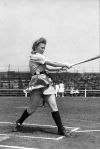It was the All-American Girls Professional Baseball League, or at least that's how we remember it today. Things changed quickly in the league, even the name of the league. It was founded in 1943 by Chicago Cubs owner Philip K. Wrigley as an alternative to the male-dominated major leagues since World War II was taking so many players from the MLB. The original name was first named the All-American Girls Softball League, but was soon changed to the All-American Girls Baseball League. It was only in 1949 and 1950 that the league had its most famous name: the All-American Girls Professional Baseball League. From 1951-54, it was simply known as the American Girls' Baseball League.
 |
| All-American Girls Professional Baseball League logo |
The teams themselves weren't the most consistent teams around either. Out of the total of 15 teams that were part of the league between 1943-1954, only two were around the whole time (South Bend Blue Sox and Rockford Peaches). The other 13 teams were Kenosha Comets (1943-51), Racine Belles (1943-50), Milwaukee Chicks (1944), Minneapolis Millerettes (1944), Fort Wayne Daisies (1945-54), Grand Rapids Chicks (1945-54), Muskegon Lassies (1946-49), Kalamazoo Lassies (1950-54), Peoria Redwings (1946-51), Chicago Colleens (1948), Springfield Sallies (1948), Battle Creek Belles (1951-52), and Muskegon Belles (1953). Some teams were moved, and some only were around for a year or two. With the exception of Minneapolis and Chicago, the teams were typically in second or even third tier Midwestern towns. They were immensely popular in these towns, but they didn't draw from out of the towns much. Each year, the top two teams would play for the championship. The team with the most championships was the Rockford Peaches. The champions are as follows: Racine Belles (1943), Milwaukee Chicks (1944), Rockford Peaches (1945), Racine Belles (1946), Grand Rapids Chicks (1947), Rockford Peaches (1948, 1949, 1950), South Bend Blue Sox (1951, 1952), Grand Rapids Chicks (1953), Kalamazoo Lassies (1954).
It might surprise you that the AAGPBL wasn't the first instance of women playing baseball in organized teams. As early as 1866, the first known women's baseball team played at Vassar College. Later, from the 1890's-1930's, barnstorming women's teams played throughout the Midwest (these were called "Bloomer Girl" teams). And most surprisingly, there were at least three women players in the Negro Leagues (Toni Stone, Mami Johnson, and Connie Morgan).
The rules themselves of the AAGPBL were different than MLB in some ways and similar in others. The AAGPBL game was like a hybrid of baseball and softball (hence the reason it started out with softball in the league name and not baseball). Firstly, in the first season, the ball used was actually the size of a softball, but eventually shrank to the size of a regulation baseball. Secondly, the distance from home plate to the mound was only 40 feet (in baseball, it's 60' 6"), but eventually the distance went to 60'. Thirdly, the distance from base to base was 65', well short of the 90' in baseball. The path was eventually extended to 85'. Fourthly, pitchers threw underhanded for a number of years. Fifthly, the uniforms and treatment of the women. The uniforms were skirts (just like in the movie "A League of Their Own"), and also like in the movie, part of spring training involved evening charm school classes on etiquette, dress, makeup, hygiene, and mannerisms. The women in the league had to adhere to a strict 'Rules of Conduct' policy that included wearing lipstick all the time, no smoking or drinking in public places, and no short hair. Not following the rules involved a $5 fine for a first offense, $10 fine for a second offense, and suspension for a third offense. Fifthly, the rate of pay was much lower than the MLB's. Players were payed between $45-$85 a week in the early years, and in later years could be as high as $125. One major similarity to MLB was the grueling schedule: the AAGPBL played 120 games over only four months. That meant they played pretty much everyday and had double-headers on holidays and Sundays.
By the end of 1954, the league was in trouble and play was suspended for the 1955 season; it never resumed. Part of the reason was money, and part of it was the American way of thinking in the 1950's. The war had been over for almost ten years, and life had returned to its quiet, suburban, car-in-every-driveway, 2.5 children nuclear family way of life that we look back on. American society wasn't ready for women to be tackling the sport that had been for so long dominated by men. Even though they had been very supportive ten years earlier, that support came mostly from a fear that the war would never end, and the even bigger fear that there weren't going to be enough men in the MLB to sustain it. How quickly things change in a decade! Even though the AAGPBL had been run by men and founded by men, it was the women players that made it successful, and it was their determination to be judged as equals in the sport that made the league work for as long as it did. Even if the league had only been around for one season, it still would've been a success for woman equality in American society. The growing feeling of 1950's conservatism is the biggest contributor to the ending of the league. The first reunion of the AAGPBL was held in Chicago in 1982, and a player's association was formed in 1987 for the surviving members of the league.
 |
| "Pepper" Paire from her glory days |
No comments:
Post a Comment